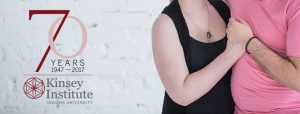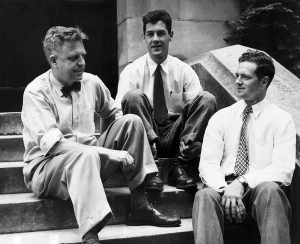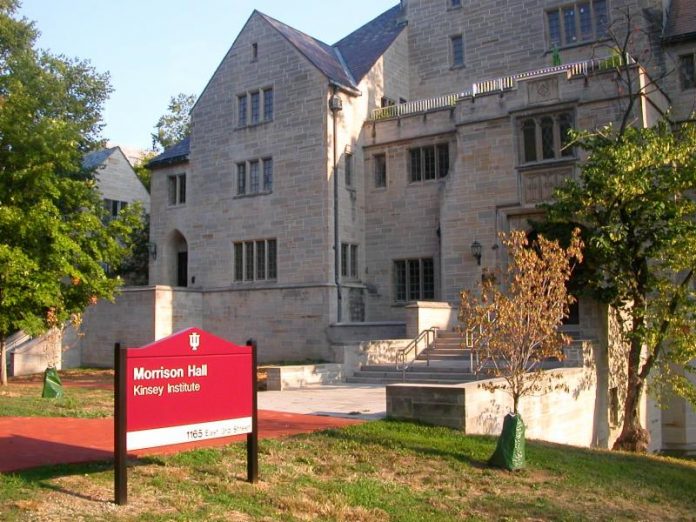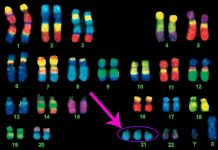Today, just as in 1947, research at the Kinsey Institute seeks to illuminate the most intimate and formative aspects of our lives.
 Developments in fields ranging from neuroscience and psychology to biology and gender studies inform questions asked by our scientists. Learn more about the scope of our research.
Developments in fields ranging from neuroscience and psychology to biology and gender studies inform questions asked by our scientists. Learn more about the scope of our research.
On April 8, 1947, Dr. Alfred Kinsey and his research team incorporated as the Institute for Sex Research. ISR had two primary goals: to continue the team’s research on human sexual behavior; and to administer research resources, including research materials, a library, case histories, and other related materials.
In 1981, 25 years after Dr. Kinsey’s death, the Institute for Sex Research was renamed The Kinsey Institute for Sex Research.
Dr. Alfred Charles Kinsey was an American biologist, professor of entomology and zoology, and sexologist. In 1947, he founded the Institute for Sex Research at Indiana University, which is now known as the Kinsey Institute.
 Dr. Kinsey arrived at Indiana University in 1920—a year after receiving his Ph.D. in biology from Harvard University. For the next 20 years, Kinsey studied gall wasps, specializing in taxonomy and individual variation. In 1938, he began teaching “Marriage and Family,” a course for senior and married IU students. During this time, Kinsey’s study into the subject of sex increased and he began collecting sex histories to strengthen his research.
Dr. Kinsey arrived at Indiana University in 1920—a year after receiving his Ph.D. in biology from Harvard University. For the next 20 years, Kinsey studied gall wasps, specializing in taxonomy and individual variation. In 1938, he began teaching “Marriage and Family,” a course for senior and married IU students. During this time, Kinsey’s study into the subject of sex increased and he began collecting sex histories to strengthen his research.
Three years later, Kinsey had gathered nearly 2,000 sex histories and earned a $1,600 grant from the National Research Council’s Committee for Research on the Problems of Sex. By 1947, the committee had funded the Kinsey team with a $40,000 grant.
Institute for Sex Research
On April 8, 1947, Kinsey and the research staff incorporated as the Institute for Sex Research (ISR). The new institute was located in IU’s Biology Hall (now Swain Hall East) with Kinsey, Paul Gebhard, Clyde Martin, and Wardell Pomeroy serving as trustees. Incorporating as a non-profit entity helped protect research data, enable more avenues of research funding, and ensure a more stable and sustainable environment for the research collections and library. In 1948, Kinsey sold the contents of his research library to ISR for $1.00. Until then, he had paid for materials out of his own pocket.
“We are the recorders and reporters of facts—not the judges of the behaviors we describe.”
– Alfred Kinsey
The Kinsey Reports
In January of 1948, W. B. Saunders and Company published Sexual Behavior in the Human Male. The wildly popular volume quickly reached number two on the New York Times Bestseller’s List with royalties going back to ISR for continued research. The complementary work, Sexual Behavior in the Human Female (W.B. Saunders), followed in 1953. Both volumes featured the Heterosexual-Homosexual Rating Scale—more commonly known as “The Kinsey Scale.”
Academic freedom at Indiana University
 According to former Kinsey Institute Director June Reinisch, “There would be no Kinsey Institute without Herman B Wells.” During his tenure as president of Indiana University, Wells doggedly took on Kinsey’s detractors in one of the most heralded instances of the protection of academic freedom in the mid-20th century.
According to former Kinsey Institute Director June Reinisch, “There would be no Kinsey Institute without Herman B Wells.” During his tenure as president of Indiana University, Wells doggedly took on Kinsey’s detractors in one of the most heralded instances of the protection of academic freedom in the mid-20th century.
After the release of Sexual Behavior in the Human Female, Wells said: “Indiana University stands today, as it has for 15 years, firmly in support of the scientific research project that has been undertaken and is being carried out by one of its eminent biological scientists, Dr. Alfred C. Kinsey. The University believes that the human race has been able to make progress because individuals have been free to investigate all aspects of life. It further believes that only through scientific knowledge so gained can we find the cures for the emotional and social maladies in our society… I agree in saying that we have large faith in the values of knowledge, little faith in ignorance.” For more, see Alma Pater: Herman B Wells and the Rise of Indiana University.
Death
Dr. Kinsey passed away unexpectedly at age 62 on August 25, 1956. Earlier that year, he gave an interview to NBC News and interviewed his last two subjects. All told, Dr. Kinsey personally took 7,985 of the approximately 18,000 sex histories gathered by the research team.
Explore Kinsey: The Kinsey Institute is powered by curiosity and inspired by humanity.
Mission: To foster and promote a greater understanding of human sexuality and relationships through impactful research, outreach, education, and historical preservation
Vision: To be the premier research institute on human sexuality and relationships.
___________________________________________________________________












